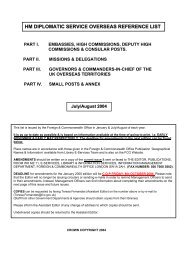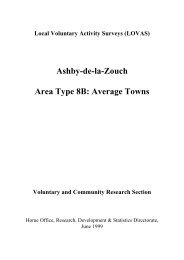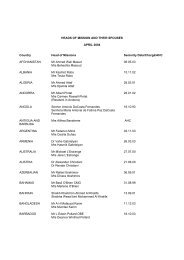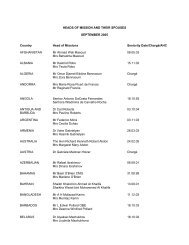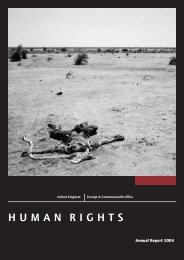A detailed guide to State Pensions for advisers and others
A detailed guide to State Pensions for advisers and others
A detailed guide to State Pensions for advisers and others
Create successful ePaper yourself
Turn your PDF publications into a flip-book with our unique Google optimized e-Paper software.
30<br />
Additional <strong>State</strong> Pension<br />
Additional <strong>State</strong> Pension was introduced in 1978 <strong>and</strong> is the part of the <strong>State</strong><br />
Pension that is related <strong>to</strong> the person’s annual earnings. It was originally referred <strong>to</strong><br />
as <strong>State</strong> Earnings Related Pension Scheme (SERPS) <strong>and</strong> became known as the<br />
<strong>State</strong> Second Pension scheme following changes introduced in April 2002.<br />
Payments are based on the amount of Class 1 annual National Insurance<br />
contributions paid, or treated as having been paid, on earnings between the<br />
National Insurance Lower <strong>and</strong> Upper Earnings Limits in each tax year.<br />
The rules also allow people <strong>to</strong> build up extra payments of additional <strong>State</strong> Pension<br />
(this used <strong>to</strong> be known as an increment) by delaying the date from which they<br />
claim their additional <strong>State</strong> Pension.<br />
[SSCBA 1992 sections 44-46 <strong>and</strong> Sch 4A]<br />
From April 2009, it is planned that the upper earnings limit will be replaced by the<br />
Upper Accrual Point (UAP) <strong>for</strong> the purpose of capping entitlement <strong>to</strong> the <strong>State</strong><br />
Second Pension. The UAP will be frozen in cash terms, leading <strong>to</strong> a gradual erosion of<br />
earnings-related accruals.<br />
Self-employed<br />
If someone has been self-employed, the National Insurance contributions they paid<br />
as a self-employed person will not count <strong>to</strong>wards any additional <strong>State</strong> Pension.<br />
Widowed or divorced<br />
There are special rules on additional <strong>State</strong> Pension <strong>for</strong> people who are widowed or<br />
divorced or whose civil partnership has ended due <strong>to</strong> the death of their civil<br />
partner or the civil partnership has been dissolved. Please see the section<br />
Inherited SERPS on page 38.<br />
How <strong>to</strong> claim additional <strong>State</strong> Pension?<br />
There is no need <strong>to</strong> apply separately <strong>for</strong> it. We will au<strong>to</strong>matically work it out when<br />
a person claims their <strong>State</strong> Pension.<br />
How <strong>to</strong> qualify?<br />
The amount paid is based on the level of a person’s earnings in each tax year from<br />
April 1978 (or the tax year in which their 16th birthday takes place, if this is later)<br />
<strong>to</strong> the tax year be<strong>for</strong>e the year in which they reach <strong>State</strong> Pension age.<br />
SERPS 1978 <strong>to</strong> 1997 – A person must have paid Class 1 National Insurance<br />
contributions on earnings that were higher than the annual Lower Earnings Limit<br />
<strong>for</strong> National Insurance contributions set <strong>for</strong> a tax year. This limit is set each year<br />
by Parliament.<br />
Additional <strong>State</strong> Pension is worked out using the amount a person has earned<br />
above this level each year. A reduction is made in the calculation of the additional<br />
<strong>State</strong> Pension if they were contracted out of the scheme during this period.<br />
(See page 38 <strong>for</strong> more in<strong>for</strong>mation on contracted-out arrangements.)<br />
SERPS 1997 <strong>to</strong> 2002 – A person qualifies if they paid st<strong>and</strong>ard rate Class1 National<br />
Insurance contributions <strong>and</strong> they were contracted in<strong>to</strong> the <strong>State</strong> scheme.<br />
(See page 38 <strong>for</strong> in<strong>for</strong>mation if they were contracted out of the <strong>State</strong> scheme.)




